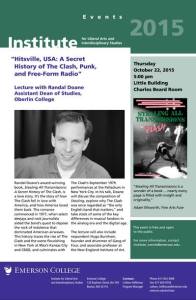Happy father’s day — to all the fathers, and to all of who have been fathered.
I’m thinking about Prince still, especially after reading anew “Life in the Arts,” from Air Guitar: Essays on Art & Democracy, by Dave Hickey:
“When Terry Allen called me in San Diego with the news that Chet Baker was dead, I just said, ‘Aw, shit!’ and hung up … I sat there for a long time in that cool, shadowy room, looking out at the California morning. I stared at the blazing white stucco wall of the bungalow across the street … I sat shivah for Chet Baker in that quiet room, acutely aware of my own breathing–aware, as well, that I had been listening to Baker breathe through his trumpet and through the language for more than thirty years.”
Did you receive a call about Prince? Who receives a call about anything anymore? The pixels on our devices beat our friends to the punch every time. Did any of us have the chance to sit quietly, to sit shivah for Prince? I took a break from work, combed the news media online, checked Facebook–but my response, and perhaps your response, too, contradicted Hickey’s response to the news about Baker. He simply hung up the phone. He knew no words would make the news not true–the loss of the artist “whose work I was forced to divine by the pure logic of sense.”
To divine the logic of Prince, I had the help of solid interpreters. It was 1984, our summer of lust, and Purple Rain was the soundtrack. My friends and I turned 16 that year and, in the suburbs of northern California, we drove, and parked, and drove some more. That July, I was still two months from my own sweet 16, but I had a copy of Purple Rain on cassette, courtesy of my friend Brian. Brian had tried to turn me onto Prince in 1983 via MtV, but on the first pass, Prince’s virtues (and virility) escaped me.
While watching the video for “Little Red Corvette,” I ventured, “That guy? He’s sexy?”
“Check out Dez, his guitarist,” Brian suggested, “and the kamikaze icon on his headband. That’s cool.”
That summer, Brian had his license, and Peggy did, too, and we finally had control of the tape decks. We no longer needed to bum rides off older siblings and, in turn, seized control of the soundtrack of our youth. I remember weekend drives with Peggy in her VW Rabbit, with Julia* in the front seat, and Brian, first, and then Noel, and me in the back. Brian had a thing for Julia, and Noel and had a thing for Julia, and I watched with bemusement, a trace of envy, and what I now regard as gratitude—for watching Julia respond to Prince reminded me of pulpit-inspired power of the best of rock‘n’roll.

In spring 1984, my cassette collection looked awfully WASP-y—as in, white Anglo synth pop: Human League, New Order, and Depeche Mode. The closest things I had in my collection to an R&B album were the debut LPs by Culture Club and Gang of Four. So yeah: not very close at all. Sure, The Thompson Twins and Heaven 17 drew upon the musical tropes of disco and funk, but the tunes of Heaven 17 were more likely to draw the ire of your parents or teachers if they recognized the Marxist sympathies of Martin Ware and co., rather than their tempered representation of longing and desire.
Nearly 20 years after Mick Jagger had professed the syncopated terms of his dissatisfaction, Prince arrived to profess with absolute clarity the terms of his ecstasy. By Purple Rain, Prince stood alone in his ability to represent our urges and gratification, lyrically and sonically. He offered sounds and words designed to get us “through this thing called life,” apropos for headphones, the dance floor, and the car stereo. Initially, though, I recognized none of it—and instantly, with a bit of help, all of it.
Julia had jet-black hair, cut above the shoulder and feathered back, which covered her forehead and ended just above her thick, well-tended eyebrows. Her haircut seemed designed for brooding, which she did often, and honestly, and sometimes outrageously—to impressive dramatic effect, if the tales of her maternal spats were even half-true. Still, when Julia met your gaze and her eyebrows jumped, and she flashed that Doublemint smile bookended by a pair of deep and perfect dimples, she reminded you of the pleasures and the dangers of beauty, for the beholder and the beholding.
Through the dry nights of summer and into autumn, we spent our nights behind the wheel, windows down, stereo on. After dark, in the suburbs of California, life was always elsewhere, so we drove. If any tape provided a respite from the heavy rotation of Purple Rain, that memory and that tape are long lost.

Prince’s sense of the end of days, and the carnal delights that preceded it, contrasted sharply with the string of judgment days, real and imagined, that constituted our adolescence. In “Let’s Go Crazy,” Prince imagined Judgment Day as the gateway to “a world of never ending happiness.” Until then, “in this life, you’re on your own.” We were young, stood within a stone’s throw of dumb, and certainly had no better than a fuzzy vision of the long game. For me, what set Prince apart, above all else, at age 26, was his freedom from shame.
Immodest couture? Nearly guaranteed. Scatalogical lyrics? Absolutely. The idea, though, that Prince could experience the emotional pain associated with the ridiculous or the indecorous was baffling. Prince offered no apologies for being Prince. Armed with unrepentant confidence, Prince reached out to touch us, to bless us, to inoculate us from fear, sacrificing his own flesh in bars of falsetto ecstasy and demi-god-like guitar solos for our salvation. The notion that someone but 10 years our senior could wrest that from this world, and that maybe we could, too, seduced Julia immediately.
The content of this memory remains fuzzy, but the affect still rings true. Peggy drove, Julia occupied the passenger seat, and Brian and I sat in the back. “Let’s Go Crazy,” or “Darling Nikki” thumped from the speakers, and Julia sat up, turned around, and gripped the headrests and said something daring, something earnest, even defiant. In that moment, Prince’s beats reflected off her torso and back upon ours. Before I could nod or smile in agreement, she whipped back around and turned up the stereo, extended her right arm out the window, palm up against the wind.
At school, alas, Julia could not sustain such defiance, especially when it came to the perils of her own beauty. In the field of adolescent desire, power is a practice, not a given. In Julia’s case, the power of beauty resided not only in her capacity to attract and hold the attention of young men, but in the power to look away, to cast aside the desire of others, as if she herself lacked such hunger. But she didn’t. She held in ravenous regard the regard of others.
As autumn turned to winter that junior year, Julia and I lost track of each other, caught up in mutually exclusive circles of friends. The following fall, we shared a class, maybe two–until she stopped missed a day or two of English, and then a few more. I saw her a week later. “You all right? What’s going on?,” I asked. “Well,” Julia said slowly, “I skipped class last week, and then I couldn’t get an excused absence, and I didn’t want to show Ms. Wattel an unexcused absence, so I just stopped coming.” A few weeks later, I saw her sitting in the quad ahead of 4th period, ahead of 6th period, and after 7th. She sat in her long coat, a coat too warm for that balmy afternoon. “Hey. Is everything okay?” I asked. “I’m fine,” she replied. “Senior portraits came out today, and I have on the same sweater I had on for the picture.”
I don’t know that we ever spoke again. Months later, Kerry, a friend of a friend, reported that she had been to Santa Cruz with friends over the weekend and, at the end of the day, they stopped for dinner at a Taco Bell. “The cashier, it was Julia!,” she said. “She had bleached her hair, dyed it strawberry blonde, and I said, ‘Hey, Julia! What are you doing here?’ I apparently said it too loudly, though, as the manager came over and said, ‘What’s going on? There’s some mistake here. Her name is Kelly.’ We got our food and left. It was Julia, Randy, I’m telling you.”
In successive years, I became a much better listener of Prince. I hope Julia did, too.
*–One or more names have been changed to protect the misunderstood.




